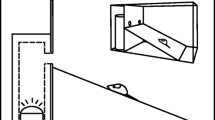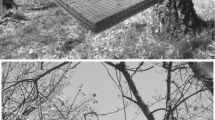Abstract
Anti-predator behaviour of breeding animals is a complex trait that depends on current reproductive investment as well as individual differences in risk-taking propensities. In response to nest predation, many bird species produce specific sounds, such as the hissing calls in incubating great tits (Parus major), that may provoke an acoustic startle response in the predator. However, it is still unclear whether the propensity of incubating females to produce hissing calls towards nest predators depends on the reproductive investment. With our 3-year study, we show that response type (females that do not hiss versus females giving hissing calls) to a potential nest predator, the woodpecker, is a repeatable trait. We found no differences in the studied reproductive traits between hissing and non-hissing birds. Interestingly, among hissing birds, fast-responding females started egg-laying earlier than slow-responding ones. Among non-hissing birds, heavier birds initiated clutches earlier. We also revealed that hissing birds breed in areas with decreased nest-box occupancy, suggesting either that they potentially select different areas to breed or that territory size is larger as a result of hissing birds being more aggressive. These findings demonstrate that response type is not related to the early reproductive value of the brood across distinct behavioural groups. However, our results do suggest that non-hissing and hissing females differ in terms of individual quality or dominance or personality related aspects.



Similar content being viewed by others
References
Amat JA (1996) Nest defence by chinstrap penguins Pygoscelis Antarctica in relation to offspring number and age. J Avian Biol 27:177–179
Andren H (1992) Corvid density and nest predation in relation to forest fragmentation: a landscape perspective. Ecology 73:794–804
Angelstam P (1986) Predation on ground-nesting birds’ nests in relation to predator densities and habitat edge. Oikos 47:365–373
Bates D, Maechler M, Bolker B, Walker S (2014) lme4: Linear mixed-effects models using Eigen and S4. R package version 1.1-6
Bell AM, Hankison SJ, Laskowski KL (2009) The repeatability of behaviour: a meta-analysis. Anim Behav 77:771–783
Bize P, Diaz C, Lindström J (2012) Experimental evidence that adult anti-predator behaviour is heritable and not influenced by behavioural copying in a wild bird. Proc R Soc B 279:1380–1388
Borgmann KL, Conway CJ, Morrison ML (2013) Breeding phenology of birds: mechanisms underlying seasonal declines in the risk of nest predation. Plos ONE 8:e65909. doi:10.1371/journal.pone.0065909
Carlisle TR (1985) Parental response to brood size in a chilid fish. Anim Behav 33:234–238
Fox J, Weisberg S (2011) Companion to applied regression. R package version 2.1-0
Gamer M (2012) Various coefficients of interrater reliability and agreement. R package version 0.84
Harris RN (1979) Aggression, superterritories, and reproductive success in Tree Swallows. Can J Zool 57:2072–2078
Hõrak P, Mänd R, Ots I, Leivits A (1995) Egg size in the Great Tit Parus major: individual, habitat and geographic differences. Ornis Fennica 72:97–114
Kluyver HN (1951) The population ecology of the Great Tit Parus m. major L. Ardea 39:1–135
Krams I, Krama T, Berzins A, Rantala MJ (2010) The risk of predation favors cooperation among breeding prey. Commun Integr Biol 3:243–244
Krams I, Vrublevska J, Koosa K, Krama T, Mierauskas P, Rantala MJ, Tilgar V (2014) Hissing calls improve survival in incubating female great tits (Parus major). Acta Etholog 17:83–88
Krebs CJ (2007) The message of ecology. Indo American Books, Delhi, India
Landis JR, Koch GG (1977) Th measurement of observer agreement for categorical data. Biometrics 33:159–174
Lessels CM, Boag PT (1987) Unrepeatable repeatabilities: a common mistake. Auk 104:116–121
Lima SL (2009) Predators and the breeding bird: behavioral and reproductive flexibility under the risk of predation. Biol Rev 84:485–513
Lòpez P, Hawlena D, Polo V, Amo L, Martín J (2005) Sources of individual shy–bold variations in anti-predator behaviour of male Iberian rock lizards. Anim Behav 69:1–9
Mahr K, Griggio M, Granatiero M, Hoi H (2012) Female attractiveness affects paternal investment: experimental evidence for male differential allocation in blue tits. Front Zool 9:14
Mänd R, Tilgar V, Lõhmus A, Leivits A (2005) Providing nest boxes for hole-nesting birds—does habitat matter? Biodivers Conserv 14:1823–1840
Mänd R, Rasmann E, Mägi M (2013) When a male changes his ways: sex differences in feeding behavior in the pied flycatcher. Behav Ecol 24:853–858
Moss R, Parr R, Lambin X (1994) Effects of testosterone on breeding density, breeding success and survival of red grouse. Proc R Soc Lond B 258:175–180
Mougeot F, Redpath SM, Leckie F, Hudson PJ (2003) The effect of aggressiveness on the population dynamics of a territorial bird. Nature 421:737–739
Naef-Daenzer B, Widmer F, Nuber M (2000) Differential post-fledging survival of great and coal tits in relation to their condition and fledging date. J Anim Ecol 70:730–738
Nakagawa S, Schielzeth H (2013) A general and simple method for obtaining R2 from generalized linear mixed-effects models. Methods Ecol Evol 4:133–142
Perrins CM (1965) Population fluctuations and clutch-size in the Great Tit, Parus major L. J Anim Ecol 34:601–647
Perrins CM (1979) British tits. Collins, London
Rytkönen S (2002) Nest defence in great tits Parus major: support for parental investment theory. Behav Ecol Sociobiol 52:379–384
Shustack D, Rodewald AD (2011) Nest predation reduces benfits to early clutch initiation in northern cardinals, Cardinalis cardinalis. J Avian Biol 42:204–209
Slagsvold T (1993) Female-female aggression and monogamy in Great Tits, Parus major. Ornis Scand 24:155–158
Tilgar V, Kikas K (2009) Is parental risk taking negatively related to the level of brood reduction? An experiment with pied flycatchers. Anim Behav 77:43–47
Tilgar V, Moks K (2015) Increased risk of predation increases mobbing intensity in tropical birds of French Guiana. J Trop Ecol 31:243–250
Tilgar V, Moks K, Saag P (2011) Predator-induced stress changes parental feeding behavior in pied flycatchers. Behav Ecol 22:23–28
Van den Assem J (1967) Territory in the three-spined stickleback Gasterosteus aculeatus L. An experimental study in intra-specific competition. Behaviour Suppl. XVI. With 96 tabl. EJ Brill, Leiden, p 164
Acknowledgements
We are especially grateful to Marko Mägi, Pauli Saag and Killu Timm for assistance with fieldwork. We thank all other members of the Avian Behavioural Ecology workgroup for help and advice. Funding came from the Estonian Ministry of Education and Research (target-financing project number 0180004s09, institutional research funding IUT number 34–8) and the European Regional Developmental Fund (Centre of Excellence, Frontiers in Biodiversity Research).
Author information
Authors and Affiliations
Corresponding author
Ethics declarations
This study was funded by Estonian Ministry of Education and Research (target-financing project number 0180004s09, institutional research funding IUT number 34–8). The study complies with the current laws of Estonia and all institutional guidelines were followed during animal treatment.
Conflict of interest
The authors declare that they have no conflict of interest.
Rights and permissions
About this article
Cite this article
Koosa, K., Tilgar, V. Is hissing behaviour of incubating great tits related to reproductive investment in the wild?. acta ethol 19, 173–180 (2016). https://doi.org/10.1007/s10211-016-0239-y
Received:
Revised:
Accepted:
Published:
Issue Date:
DOI: https://doi.org/10.1007/s10211-016-0239-y




